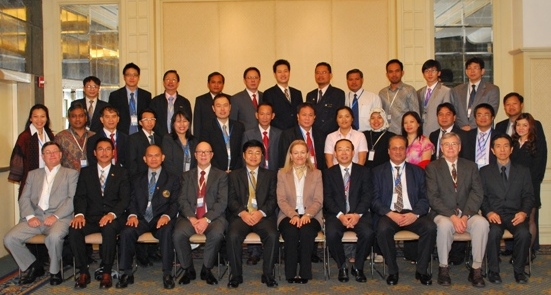Seminar 4 (S4): UNFC Resource Classification (for Oil, Gas and Minerals), organized in cooperation with UNECE and UNESCAP,
9-10 February 2012, Bangkok, Thailand
2012-02-09
2012-02-10
About the Seminar/Workshop
The Seminar/Workshop was organized by the Coordinating Committee for Geoscience Programs in East and South-east Asia (CCOP), in cooperation with United Nations Economic Commission for Europe (UNECE) and United Nations Economic Commission for Asia and Pacific (UNESCAP), under its Enhancing Public Petroleum Management Program (funded by the Norwegian Government). The goal of the EPPM Program is to create the highest possible value for society from petroleum resources in order to improve the quality of life of the people in CCOP Member Countries.

This is the 4th Annual Seminar / Workshop (S4) that supports the technical activities of the EPPM Program and participated by representatives from the minerals and petroleum sectors from Cambodia, China, Indonesia, Korea, Lao People's Democratic Republic, Malaysia, the Philippines, Thailand and Vietnam. The objectives are to review the current state-of-the-art in petroleum and mineral resource classification and to present the only global classification system, United Nations Framework Classification (UNFC) 2009, for both petroleum and minerals. Also, to explain and discuss the potential for the United Nations Framework Classification (UNFC - 2009) to provide a global communication tools that can be applied easily by the CCOP Member Countries.
Contents:
1. Workshop Leaflet (Program, Note for Information and List of Participants)
2. Summary
3. Photos (see S4 Gallery)
4. Presentations & Discussions
A. Introduction, housekeeping and Workshop background – Mr. Simplicio P. Caluyong, EPPM Program Coordinator, CCOP Technical Secretariat
B. UNFC – Who, What and Why? – Ms. Charlotte Griffiths, UNECE
C. Stakeholder Requirements and Developing Specifications for UNFC 2009 – Ms Charlotte Griffiths, UNECE
D. Purpose of Resource Classification, Fundamental Principles and System Applications – Mr. Per Blystad, Norwegian Petroleum Directorate, Norway
E. Overview of UNFC 2009 - Mr. Per Blystad, Norwegian Petroleum Directorate, Norway
F. UNFC 2009 – application examples for Oil & Gas - Mr. Per Blystad, Norwegian Petroleum Directorate, Norway
G. National Mineral Resources Classification and Reporting Systems and UNFC 2009 – An Australian perspective- Dr. Ian Lambert, Geoscience Australia, Australia
H. Overview of application of the UNFC to minerals: the CRIRSCO Template and its relationship with the UNFC – Dr. Ian Lambert, Geoscience Australia, Australia
I. Overview of UNFC for Petroleum Resources, PRMS and Relationship to UNFC 2009 - Dr. Satinder Purewal, Energy Equity Resources Limited, UK
J. Examples of Application of PRMS and UNFC 2009 – Dr. Satinder Purewal, Energy Equity Resources Limited, UK
5. CCOP Member Countries Classification System
A. Cambodia - Petroleum and Mineral Resource Classification
B. China - Petroleum Resource Classification System
C. Indonesia – Indonesian Standard on Coal Resources and Reserves Classification
D. Indonesia – Guidance for Classification, Estimation, and Reporting of National Oil and Natural Gas Reserves
E. Korea – (KIGAM) – Standardization of the Evaluation Criteria on Petroleum Resources
F. Malaysia – Overview of PETRONAS Definitions and Guidelines for Classification of Petroleum Resources
G. Philippines – The Philippine Petroleum Resource Classification System
H. Thailand- Electricity Generating Authority of Thailand (EGAT) Coal Classification
I. Thailand – Overview on Mineral Resource Classification of Thailand
J. Thailand – Petroleum Reserves Classification in Thailand
K. Vietnam – Classification of Solid Mineral Resources and Reserves in Vietnam
L. Vietnam - Vietnam Petroleum Resource Classification 2011
6. Mapping of the UNFC, Energy Series No. 33, UNECE
7. UNECE Press Release: UNFC – enhanced energy security and sustainability (15 February 2012) - http://www.unece.org/energywelcome/press-releases.html
| 


